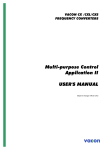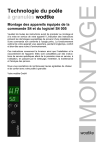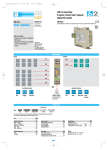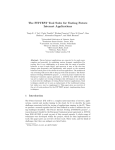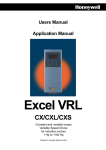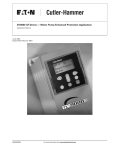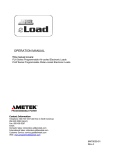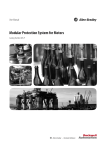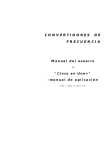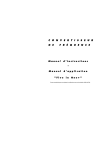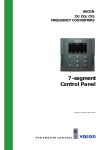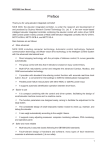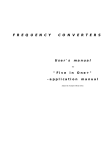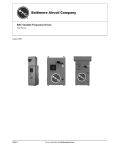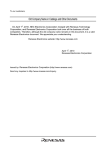Download SV9000 AF DRIVES - ElectricalManuals.net
Transcript
Page i Fast Closed Loop Application SV9000 SV9000 AF DRIVES Fast Closed Loop Control Application Page ii Fast Closed Loop Application SV9000 Page iii Fast Closed Loop Application SV9000 Fast Closed Loop Application Contents 1 General........................................................ 1 1.1 Control I/O............................................. 1 1.2 Control Signal Logic.............................. 2 1.3 Parameter Group 0 ............................... 3 2 Closed Loop Commissioning....................... 5 2.1 Sequence of actions ............................. 5 2.2 Auto-tuning............................................ 5 3 Group 1, Basic parameters ......................... 7 3.1 Group 1 Parameter Table ..................... 7 4 Groups 2—12, Special parameters............. 9 4.1 Groups 2—12 Parameter Tables.......... 9 5 Parameter Descriptions, Group 1.............. 18 6 Parameter Descriptions, Groups 2—12 .... 22 7 Fault codes ................................................ 52 8 Monitoring data.......................................... 52 Page iv Fast Closed Loop Application SV9000 SV9000 Fast Closed Loop Application Page 1 (56) 1 General The Fast Closed Loop Application provides parameters for torque control and fieldbus communication, with both open loop control and closed loop control algorithms. Closed loop control modes can be used to improve performance near zero speed and improve static and dynamic speed and torque accuracy at higher speeds. Closed loop control modes are based on full vector control. With this control principle, the phase currents are divided into a torque producing current component and a magnetizing current component, which allows the three-phase induction motor to be controlled like a traditional DC-motor. Fast Closed Loop Control includes: * 10ms resolution ramp times * fast analog input with 1 ms update interval * encoder input 1.1 Control I/O Terminal READY RUN 220 VAC Signal Description Reference output Voltage for potentiometer, etc. Vin+ Analog input, voltage (programmable) Frequency reference range 0—10 VDC 3 GND I/O Ground Ground for reference and controls 4 Iin+ 5 Iin- Analog input current (programmable) Default setting: not used, range 0—20 mA 6 +24V Control voltage output Voltage for switches, etc. max 0.1 A 7 GND I/O ground Ground for reference and controls 8 DIA 1 Start forward (programmable) Contact closed = start forward 9 DIA 2 Start reverse (programmable) Contact closed = start reverse 10 DIA 3 Fault reset (programmable) Contact open = no action Contact closed = fault reset 11 CMA Common for DIA 1—DIA 3 Connect ot GND or +24V 12 +24V Control voltage output Voltage for switches (see #6) 13 GND I/O ground Ground for reference and controls 14 DIB4 Jogging speed select (programmable) Contact open = no action Contact closed = jogging speed 15 DIB5 External fault (programmable) Contact open = no fault Contact closed = fault 16 DIB6 Acceleration/deceleration time select (programmable) Contact open = par. 1.3, 1.4 in use Contact closed = par. 4.3, 4.4 in use 17 CMB Common for DIB4—DIB6 Connect to GND or +24V 18 Iout+ 19 Iout- Ouput frequency Analog output Programmable (par. 3.1) Range 0—20 mA/RL, max. 500Ω 20 DO1 Digital output READY Programmable, par. 3.6 Open collector, I≤50mA, U≤48 VDC 21 RO1 22 RO1 23 RO1 1 +10Vref 2 24 RO2 25 26 RO2 RO2 Relay output 1 RUN Programmable, par. 3.7 Relay output 2 FAULT Programmable, par. 3.8 Figure 1-1: Default I/O Configuration and Connection; Closed Loop Application Example Page 2 (56) 1.2 Fast Closed Loop Application SV9000 Control Signal Logic Figure 1-2 presents the logic of the I/O-control signals and push button signals from the panel. PARAMETERS 1.5 Reference selection 1.6 Jogging speed ref. 10.1 Fieldbus control V in + PROGRAMMABLE PUSH-BUTTON 2 Joystick control V in + P Joystick control Vin + Iin Vin - Iin Iin - Vin Vin x Iin min(Vin + Iin) max(Vin - Iin) Internal frequency reference Fieldbus Iin – Multi-step speeds (If any of DI_ inputs are programmed for this function) Par . 6.1 Motor control mode Motor control mode Torque control DIA3 (par. 2.2=10) DIB5 Up Motorised potentioDIB6 Down meter reference Jog speed DIB4 selection (programmable) Torque reference scaling Par . 9.1 Torque reference selection Internal Start/Stop P DIA1 Start FWD Programm. Start/Stop DIA2 Start REV and Reverse signal logic DIA3 Fault reset Torque reference Internal reverse Fieldbus P Fieldbus >1 Internal fault reset (programmable) DIB5 External fault (programmable) DIB6 Accel./deceler. time select (programmable) = control line = signal line Figure 1-2: Closed Loop Application Control Signal Logic. Switch positions correspond to factory settings. MP2BLOCK . SV9000 1.3 Page 3 (56) Parameter Group 0 Number 0.1 Fast Closed Loop Application Parameter Application selection Range 0—7 Step 1 Default Customer 1 Description 0 = Fast Closed Loop (loaded special application) 1 = “FB Closed Loop” Application 0 = Loading ready / Select loading 1 = Load default setting 2 = Read up parameters to user's set 3 = Download user's set parameters 0.2 Parameter loading 0—5 1 0 4 = Upload parameters to the panel (possible with alpha-numerical and graphical panel) 5 = Download parameters from the panel (possible only with alpha-numerical or graphical panel) 0.3 Language selection 0 0 = English Table 1-1. Parameter Group 0. 1.3.1 Application selection With system software sm00099j or later the Closed Loop Application has been integrated to the unit as application 1. The closed loop application is loaded separately from the system software, and will appear on the menu as application 0 - “ CL.” 1.3.2 Parameter loading See User's Manual, Chapter 11. 1.3.3 Language With this parameter, the language of the graphical panel can be selected. Page 4 (56) Fast Closed Loop Application SV9000 SV9000 Fast Closed Loop Application Page 5 (56) 2 Closed Loop Commissioning 2.1 Sequence of actions Auto-tuning requires that the motor is not loaded. If it is not possible to disconnect the load or run with a light load, parameters P10.2, 10.3, 10.4 and 10.5 must be set manually. 1. Check very carefully the encoder connections and encoder supply voltages. Check the brake resistor connection. 2. Do all normal commissioning phases 1-10 in openloop, see Cutler-Hammer SV9000 User manual chapter 8.2. 3. Set the displayed rpm to “ENCODER RPM” (P3.26=1). Run the motor in openloop with different frequencies. Check that the displayed RPM equals to the assumed RPM. Negative number to forward direction indicates wrong encoder direction. This can be corrected by setting P10.2=1. Zero rpm indicates problems with encoder. Check. 4. Run the motor with about 2/3 of the nominal frequency with low load. The motor current should be the magnetising current, which is usually about one thrid of the nominal current. Check the displayed torque to insure that load is low. If there is friction, the measured current can be higher than the magnetising current. 5. Activate the brake chopper and set the closed loop control mode (P6.1=3), set first speed control gain to low value (20) and integral time to at least 30. Set motor magnetising current to one third of the motor nominal current or to the measured no-load current. 6. Put a zero speed reference and start. If fault F32 appears, reverse the encoder direction (P10.2). Fault F31 indicates problems with encoder. Run with about 2/3 of the nominal frequency with low load Adjust the motor magnetising current to achieve about 2/3 of the motor nominal voltage. 7. Increase the load. If the motor voltage changes lot, adjust the motor nominal speed (P1.12). 8. Increase the speed control gain and decrease the integral time for tighter control. It must be noted that the speed controllers have to be stable also in torque control mode. This is because the maximum speed is limited with speed controllers. 9. Increase the speed control gain and decrease the integral time for tighter control. It must be noted that the speed controllers also must be stable in torque control mode. This is because the maximum speed is limited with the speed controllers. 2.2 Auto-tuning Autotuning can be used to measure the magnetising current, change the encoder direction and set the speed control parameters automatically. The motor load should be low. The control program controls the frequency, so the motor should be disconnected from the process. The gear and possible additional inertia should be present for proper speed control gain setting. 1) Activate auto-tuning by setting P10.8=1 and by starting the motor within 10 seconds Identification run should last few seconds and the motor will stop. Identification corrects the encoder direction, measures the magnetising current and determines suitable speed control parameter values. These can be further adjusted for improved performance. Autotuning can also be used to improve the open loop performance. Page 6 (56) Fast Closed Loop Application SV9000 SV9000 Fast Closed Loop Application Page 7 (56) 3 Group 1, Basic parameters 3.1 Group 1 Parameter Table Code Parameter Range Step Default 1.1 Minimum frequency 0—120/500 Hz 1 Hz 0 Hz 1 Description Page 18 1.2 Maximum frequency 0—120/500 Hz 1 Hz 60 Hz 1.3 Acceleration time 1 0.1—3000 s 0.1 s 3s Time from fmin (1.1) to fmax (1.2) 18 1.4 Deceleration time 1 0.1—3000 s 0.1 s 3s Time from fmax (1.2) to fmin (1.1) 18 0 = Vin 1 = Iin 2 = Vin + Iin 3 = Vin – Iin 4 = Iin – Vin 5 = Vin * Iin 6 = Vin joystick control 7 = Iin joystick control 8 = Signal from internal motor pot. 9 = Signal from internal motor pot. reset if unit is stopped 10 = Signal from internal motor potentiometer is stored in memory if power is removed 11= Min (Vin, Iin) 12 = Max (Vin, Iin) 13 = Panel reference r1 14 = Max Frequency 15 = Vin / Iin Reference Selection 18 1.5 Reference selection 0—15 1 0 S TO P 1.6 Jogging speed reference fmin – fmax (1.1) (1.2) 0.1 Hz 5 Hz 1.7 Current limit 0.1—2.5 x InSV9 0.1 A 1.5 x IcSV9 18 20 Output current limit [A] of the unit 20 20 1.8 V/Hz ratio selection S TO P 0—2 1 0 0 = Linear 1 = Squared 2 = Programmable V/f ratio 1.9 V/Hz optimisation S TO P 0—1 1 0 0 = None 1 = Automatic torque boost 21 180—690 1V 230 V 400 V 500 V 690 V Voltage code 8 Voltage code 11 Voltage code 16 Voltage code19 (Vn on the rating plate of the motor) 21 30—500 Hz 1 Hz 60 Hz fn on the rating plate of the motor 21 1.10 Nominal voltage of the motor 1.11 Nominal frequency S TO P of the motor 1.12 1.13 1.14 S TO P Nominal speed of the motor STO P 300—20000 rpm 1 rpm 1765 rpm nn on the rating plate of the motor 21 Nominal current of the motor S TO P 2.5 x InSV9 0.1 A InSV9 In on the rating plate of the motor 21 S TO P 180—250 380—440 380—500 525—690 Voltage code 8 Voltage code 11 Voltage code 16 Voltage code19 (Vn on the rating plate of the motor) 21 Supply voltage 230 V 380 V 480 V 575 V 1.15 Parameter conceal 0—1 1 0 Visibility of parameters: 0 = All parameter groups visible 1 = Only group 1 visible 21 1.16 Parameter value lock 0—1 1 0 Disables parameter changes: 0 = Changes enabled 1 = Changes disabled 21 Notes! = 1 Custom S TO P Parameter value can be changed only when the frequency converter is stopped. If 1.2 > motor synchronising speed, check suitability for motor and drive system. Page 8 (56) Fast Closed Loop Application SV9000 SV9000 Fast Closed Loop Application Page 9 (56) 4 Groups 2—12, Special parameters 4.1 Groups 2—12 Parameter Tables Group 2, Input Signal Parameters Code Parameter Range Step Default Custom Description DIA1 2.1 2.2 Start/Stop logic selection 0—5 1 0 S TO P DIA3 function (terminal 10) 0—10 1 7 S TO P 2.3 DIB4 function (terminal 14) 0—10 1 6 S TO P 2.4 DIB5 function (terminal 15) 0—11 1 DIB6 function (terminal 16) 0—11 1 Vin signal range 2.7 2.8 0 = Not used 1 = External fault, closing contact 2 = External fault, opening contact 3 = Run enable 4 = Accel./decel. time selection 5 = Reverse 6 = Jog speed 7 = Fault reset 8 = Accel./decel. operation prohibit 9 = DC-braking command 10 = Torque control 0 = Not used 1 = External fault, closing contact 2 = External fault, opening contact 3 = Run enable 4 = Accel./decel. time selection 5 = Reverse 6 = Jog speed 7 = Fault reset 8 = Accel./decel. operation prohibit 9 = DC-braking command 10 = Multi-step speed select 1 22 24 25 1 25 4 0 = Not used 1 = External fault, closing contact 2 = External fault, opening contact 3 = Run enable 4 = Accel./decel. time selection 5 = Reverse 6 = Jog speed 7 = Fault reset 8 = Accel./decel. operation prohibit 9 = DC-braking command 10 = Multi-step speed select 3 11 = Motorised pot. speed down 25 0 = 0—10 V 1 = Custom setting range 2 = -10—+10 V (can only be used with joystick control) 25 S TO P 2.6 Start reverse Reverse Run enable Stop pulse Run enable 0 = Not used 1 = External fault, closing contact 2 = External fault, opening contact 3 = Run enable 4 = Accel./decel. time selection 5 = Reverse 6 = Jog speed 7 = Fault reset 8 = Accel./decel. operation prohibit 9 = DC-braking command 10 = Multi-step speed select 2 11 = Motorised pot. speed up S TO P 2.5 0 = Start forward 1 = Start/Stop 2 = Start/Stop 3 = Start pulse 4 = Start/stop pulse 5 = Forw/Motpotup Page DIA2 0—2 1 0 Vin custom setting min. 0—100% 0.01% 0.00% 25 Vin custom setting max. 0—100% 0.01% 100.00% 25 Page 10 (56) Code Fast Closed Loop Application Parameter Range Step Default 2.9 Vin signal inversion 0—1 1 0 2.10 Vin signal filter time 0—10 s 0.01 s 0.1 s 2.11 Iin signal range 0—2 1 0 2.12 Iin custom setting min. 0—100% 0.01% 0.00% 2.13 Iin custom setting max. 0—100% 0.01% 100.0% 2.14 Iin signal inversion 2.15 Iin signal filter time 0—1 1 0 0—10 s 0.01 s 0.1 s 0.01% 0% Custom SV9000 Description Page 0 = Not inverted 1 = Inverted 26 0 = No filtering 26 0 = 0—20 mA 1 = 4—20 mA 2 = Custom setting range 26 26 26 0 = Not inverted 1 = Inverted 26 0 = No filtering 27 0% = no minimum scaling 27 100% = no maximum scaling 27 0% = no minimum scaling 27 2.16 Vin minimum scaling -320.00%– +320.00% 2.17 Vin maximum scaling -320.00%– +320.00% 0.01% 100% 2.18 Iin minimum scaling -320.00%– +320.00% 0.01% 0% 2.19 Iin maximum scaling -320.00%– +320.00% 0.01% 100% 100% = no maximum scaling 27 0 0 = Not used 1 = Vin (analog voltage input) 2 = Iin (analog current input) 3 = Ain1 (option board) 4 = Ain2 (option board) 5 = FB Signal 28 0 = No function 1 = Reduces current limit (par. 1.7) 2 = Reduces DC-braking current 3 = Reduces acc. and dec. times 4 = Reduces torque superv. limit 29 2.20 Free analog input, signal selection 2.21 Free analog input, function 2.22 Motorised potentiometer ramp time Note! S TO P 0—5 1 0—4 1 0 0.1— 2000.0 Hz/s 0.1 Hz/s 10.0 Hz/s = Parameter value can be changed only when the frequency converter is stopped. 30 SV9000 Fast Closed Loop Application Page 11 (56) Group 3, Output and supervision parameters Code Parameter Range Step Default Custom Description 0 = Not used 1 = O/P frequency 2 = Motor speed 3 = O/P current 4 = Motor torque 5 = Motor power 6 = Motor voltage 7 = DC-link volt. Scale 100% (0—fmax) (0—max. speed (0—2.0 x InSV) (0—2 x TnSV) (0—2 x PnSV) (0—100%xVnM) (0—1000 V) Page 30 3.1 Analog output function 0—7 1 1 3.2 Analog output filter time 0.01—10 s 0.01 1.00 3.3 Analog output inversion 0—1 1 0 0 = No Inversion 1 = Inverted 30 3.4 Analog output minimum 0—1 1 0 0 = 0 mA 1 = 4 mA 30 3.5 Analog output scale 10—1000% 1% 100% 3.6 Digital output function 30 31 0—21 1 1 0 = Not used 1 = Ready 2 = Run 3 = Fault 4 = Fault inverted 5 = Overheat warning 6 = External fault or warning 7 = Reference fault or warning 8 = Warning 9 = Reversed 10 = Jogging speed selected 11 = At speed 12 = Motor regulator activated 13 = Output frequency limit superv. 1 14 = Output frequency limit superv. 2 15 = Torque limit supervision 16 = Reference limit supervision 17 = External brake control 18 = Control from I/O terminals 19 = Frequency converter temperature limit supervision 20 = Unrequested rotation direction 21 = External brake control inverted S TO P 32 3.7 Relay output 1 function STO P 0—21 1 2 As parameter 3.6 31 3.8 Relay output 2 function STO P 0—21 1 3 As parameter 3.6 32 3.9 Output frequency limit 1 supervision function 0—2 1 0 0 = Not Used 1 = Low limit 2 = High limit 33 3.10 Output frequency limit 1 supervision value 0—fmax (par. 1.2) 0.1 Hz 0 Hz 3.11 Output frequency limit 2 supervision function 0—2 1 0 3.12 Output frequency limit 2 supervision value 0—fmax (par. 1.2) 0.1 Hz 0 Hz 3.13 Torque limit supervision function 0—2 1 0 3.14 Torque limit supervision value 0— 200% x TnSV 1% 100% 3.15 Reference limit supervision function 0—2 1 0 3.16 Reference limit supervision value 0—fmax 0.1 Hz 0 Hz 33 0 = Not Used 1 = Low limit 2 = High limit 33 33 0 = Not Used 1 = Low limit 2 = High limit 33 33 0 = Not Used 1 = Low limit 2 = High limit 33 33 Page 12 (56) Code Fast Closed Loop Application Range Step Default 3.17 External brake closing delay 0—100.0 s 0.1 s 0.5 s 34 3.18 External brake opening delay 0—100.0 s 0.1 s 1.5 s 34 3.19 Frequency converter temperature limit supervision function 0—2 1 0 3.20 Frequency converter temperature limit value -10—+75°C 1°C +40°C 3.21 I/O-expander board (opt.) analog output content 0—9 1 3 3.22 I/O-expander board (opt.) analog output filter time 0.01—10 s 0.01 1.00 3.23 I/O-expander board (opt.) analog output inversion 0—1 1 0 See parameter 3.3 34 3.24 I/O-expander board (opt.) analog output minimum 0—1 1 0 See parameter 3.4 34 3.25 I/O-expander board (opt.) analog output scale 10—1000% 1 100% See parameter 3.5 34 3.26 Displayed Speed 0-1 1 0 0 = Calculated RPM 1 = Encoder RPM 34 Note! Parameter S TO P Custom SV9000 Description 0 = Not Used 1 = Low limit 2 = High limit Page 34 34 See parameter 3.1 34 34 = Parameter value can be changed only when the frequency converter is stopped. SV9000 Fast Closed Loop Application Page 13 (56) Group 4, Drive control parameters Code Parameter Range Step Default Description Page 0.0 s 0 = Linear >0 = S-curve acceleration/deceleration time 35 0.0 s 0 = Linear >0 = S-curve acceleration/deceleration time 35 4.1 Acceleration/deceleration ramp 1 shape 0—10 s 0.1 s 4.2 Acceleration/deceleration ramp 2 shape 0—10 s 0.1 s 4.3 Acceleration time 2 0.1—3000 s 0.1 s 10.0 s 4.4 Deceleration time 2 0.1—3000 s 0.1 s 10.0 s Custom 35 35 0—2 1 0 0 = No (brake chopper not in use) 1 = Yes (brake chopper in use) 2 = Yes External (external brake chopper) Start function 0—1 1 0 0 = Ramping 1 = Flying Start 35 4.7 Stop function 0—1 1 0 0 = Coasting 1 = Ramping 36 4.8 DC-braking current 0.15—1.5 x InSV (A) 0.1 A 0.5 x InSV 4.9 DC-braking time at Stop 0—250.0 s 0.1 s 0s 4.10 Execute frequency of DCbrake during ramp stop 0.1—10 Hz 0.1 Hz 1.5 Hz 4.11 DC-brake time at Start 0.0—25.0 s 0.1 s 0.0 s 0.1 Hz 10.0 Hz 38 4.5 Brake chopper 4.6 STO P 35 36 0 = DC-brake is off at Stop 36 37 0 = DC-brake is off at Start 37 4.12 Multi-step speed reference 1 fmin–fmax (1.1) (1.2) 4.13 Multi-step speed reference 2 fmin–fmax (1.1) (1.2) 0.1 Hz 15.0 Hz 38 4.14 Multi-step speed reference 3 fmin–fmax (1.1) (1.2) 0.1 Hz 20.0 Hz 38 4.15 Multi-step speed reference 4 fmin–fmax (1.1) (1.2) 0.1 Hz 25.0 Hz 38 4.16 Multi-step speed reference 5 fmin–fmax (1.1) (1.2) 0.1 Hz 30.0 Hz 38 4.17 Multi-step speed reference 6 fmin–fmax (1.1) (1.2) 0.1 Hz 40.0 Hz 38 4.18 Multi-step speed reference 7 fmin–fmax (1.1) (1.2) 0.1 Hz 50.0 Hz 38 Note! S TO P = Parameter value can be changed only when the frequency converter is stopped. Page 14 (56) Fast Closed Loop Application SV9000 Group 5, Prohibit frequency parameters Code Parameter Range Step Default 5.1 Prohibit frequency range 1 low limit 0—fmax (1.2) 0.1 Hz 0 Hz 5.2 Prohibit frequency range 1 high limit 0—fmax (1.2) 0.1 Hz 0 Hz 5.3 Prohibit frequency range 2 low limit 0—fmax (1.2) 0.1 Hz 0 Hz 5.4 Prohibit frequency range 2 high limit 0—fmax (1.2) 0.1 Hz 0 Hz 5.5 Prohibit frequency range 3 low limit 0—fmax (1.2) 0.1 Hz 0 Hz 5.6 Prohibit frequency range 3 high limit 0—fmax (1.2) 0.1 Hz 0 Hz Step Default Custom Description Page 39 0 = Prohibit range 1 is off 39 39 0 = Prohibit range 2 is off 39 39 0 = Prohibit range 3 is off 39 Group 6, Motor control parameters Code 6.1 Parameter Range Motor control mode 6.3 Switching frequency Field weakening point Description Page 0 = Frequency control 1 = Speed control (open loop) 2 = Torque control (open loop) 3 = Speed control (closed loop) 4 = Torque control (closed loop) 40 Depending on kW 40 0—4 1 0 S TO P 1—16 kHz 0.1 kHz 10/3.6 kHz S TO P 30—500 Hz 1 Hz Par. 1.11 40 40 S TO P 6.2 Custom 6.4 Voltage at field weakening point S TO P 15—200% x Vnmot 1% 100% 6.5 V/Hz-curve mid-point frequency S TO P 0—500 Hz 1 Hz 0 Hz No effect in Closed Loop motor control mode. 41 6.6 V/Hz-curve mid-point voltage STO P 0—123.20% 0.01% 0.00% No effect in Closed Loop motor control mode. 41 6.7 Output voltage at zero frequency STO P 0—40% 0.01% 0.00% No effect in Closed Loop motor control mode. 41 6.8 Overvoltage controller 1 0 = Off 1 = On 2 =Mode 2 No effect in Closed Loop motor control mode. 41 1 0 = Off 1 = On No effect in Closed Loop motor control mode. 41 STO P 6.9 Note! Undervoltage controller S TO P 0—2 0—1 1 1 = Parameter value can be changed only when the frequency converter is stopped. SV9000 Fast Closed Loop Application Page 15 (56) Group 7, Protections Code 7.1 Parameter Response to reference fault Range 0—3 Step 1 Default Custom Description Page 0 0 = No Action 1 = Warning 2 = Fault (stop according to par. 4.7) 3 = Fault, Coast (stop by coasting) 42 42 7.2 Response to external fault 0—3 1 2 0 = No Action 1 = Warning 2 = Fault (stop according to par. 4.7) 3 = Fault, Coast (stop by coasting) 7.3 Phase supervision of motor 0—2 2 2 0 = No Action 1 = Warning 2 = Fault 42 7.4 Earth fault protection 0—2 2 2 0 = No Action 1 = Warning 2 = Fault 42 7.5 Motor thermal protection 0—2 1 2 0 = No action 1 = Warning 2 = Fault 43 7.6 Motor thermal protection break point current 50.0—150% x InMOTOR 1.0% 100.0% 44 7.7 Motor thermal protection zero frequency current 5.0—150% x InMOTOR 1.0% 45.0% 44 7.8 Motor thermal protection time constant 0.5—300.0 minutes 0.5 min 7.9 Motor thermal protection breakpoint frequency 10—500 Hz 1 Hz 35 Hz 7.10 Stall protection 0—2 1 1 7.11 Stall current limit 10.0—200% x InMOTOR 0.1% 130.0% 46 2.0—120 s 1.0 s 15.0 s 46 1—fmax 1 Hz 25 Hz 7.12 Stall time 7.13 Maximum stall frequency 7.14 Underload protection 7.15 Default value is set according to motor nominal current 44 45 0 = No Action 1 = Warning 2 = Fault 46 46 0 = No Action 1 = Warning 2 = Fault 0—2 1 0 47 Underload protection, field weakening area load 10.0—150% x TnMOTOR 1.0% 50.0% 47 7.16 Underload protection, zero frequency load 5.0—150.0% x TnMOTOR 1.0% 10.0% 47 7.17 Underload time 2.0—600.0 s 1.0 s 20.0 s 47 Page 16 (56) Fast Closed Loop Application SV9000 Group 8, Autorestart parameters Code Parameter Range Step Default 8.1 Automatic restart: number of tries 0—10 1 0 8.2 Automatic restart: trial time 1—6000 s 1s 30 s 8.3 Automatic restart: start function 0—1 1 8.4 Automatic restart after undervoltage trip 0—1 8.5 Automatic restart after overvoltage trip 8.6 Custom Description 0 = Not in use Page 48 48 0 0 = Ramp 1 = Flying start 48 1 0 0 = No 1 = Yes 48 0—1 1 0 0 = No 1 = Yes 48 Automatic restart after overcurrent trip 0—1 1 0 0 = No 1 = Yes 48 8.7 Automatic restart after reference fault 0—1 1 0 0 = No 1 = Yes 48 8.8 Automatic restart after over/under-temperature fault 0—1 1 0 0 = No 1 = Yes 48 Group 9, Fast Analog input Code Parameter Range Step Default 0—5 1 0 Page 49 100% 0 = Not in use 49 1% 100% 100% = No scaling 49 1mV 0 mV Source 9.2 Gain -300 - 300% 1% 9.3 Bias -300 - 300% -10000 10000 Offset Description 0 = Off 4 = Opt Vin 5 = Opt Joystick 9.1 9.4 Custom 49 Group 10, Fieldbus parameters Code Parameter Range Step Default 300-5000 1 1024 P/R Custom Description Page 10.1 Opt Joystick 50 10.2 Encoder direction 0—1 1 0 10.3 Motor magnetising current 0-2000A 0.1 A 0A 50 10.4 Speed control P 0-500 1 30 50 10.5 Speed control I 0-1000 1 10 10.6 0Hz time start 0-2,00 s 0,01 s 0,30 s 50 10.7 0Hz time stop 0-2,00 s 0,01 s 1,00 s 50 10.8 Identification 0—1 1 0 10.9 Curr Cntrl Gain 0-500 1 150 10.10 Enc filt time 01000ms 1ms 0 10.11 Ref filt time 01000ms 1 ms 5 ms 0=Forward 1=Reverse 0 = None 1 = Even 2 = Odd 0=Not Used 1=Identify 50 50 50 51 0 = Automatic 51 51 SV9000 Fast Closed Loop Application Page 17 (56) Page 18 (56) Fast Closed Loop Application SV9000 5 Parameter Descriptions, Group 1 1.1 Minimum frequency [“Min Frequency”; Range: 0—120/500 Hz; Default: 0 Hz] 1.2 Maximum frequency [“Max Frequency”; Range: 0—120/500 Hz; Default: 60 Hz] Defines the upper and lower frequency limits for the frequency converter. Parameters 1.1 and 1.2 have two frequency ranges: - 0—120 Hz ( with 0.01 Hz resolution) or - 0—500Hz (with 0.1 Hz resolution). The initial frequency range for parameters 1.1 and 1.2 is 0—120 Hz, with a resolution of 0.01 Hz. To use the second frequency range (0—500 Hz), set parameter 1.2 = 120 Hz when the device is stopped (RUN indicator not lit). This also changes the resolution to 0.1 Hz. To return to the initial frequency range, set parameter 1.2 =119 Hz when the device is stopped (RUN indicator not lit). 1.3 Acceleration time 1 [“Accel Time 1”; Range: 0.1—3000 s; Default: 3 s] 1.4 Deceleration time 1 [“Decel Time 1”; Range: 0.1—3000 s; Default: 3 s] These limits correspond to the time required for the output frequency to accelerate from the set minimum frequency (fmin, parameter 1.1) to the set maximum frequency (fmax, parameter 1.2). 1.5 Reference selection [“Ref Selection 1”; Range: 0—15; Default: 0] 0 Analog voltage reference from terminals 2 - 3, e.g. potentiometer 1 Analog current reference from terminals 4 - 5, e.g. transducer 2 Reference is obtained by adding the voltage input (Vin – terminal 2) value to the current input (Iin – terminal 4) value 3 Reference is obtained by subtracting the voltage input (Vin – terminal 2) value from the current input (Iin – terminal 4) value. 4 Reference is obtained by subtracting the current input (Iin – terminal 4) value from the voltage input (Vin – terminal 2) value 5 Reference is obtained by multiplying the voltage input (Vin – terminal 2) value and the current input (Iin – terminal 4) value SV9000 Fast Closed Loop Application 6 Page 19 (56) Joystick control from the voltage input (Vin) Signal range Max reverse speed Direction change Max. forward speed 0—10 V 0V 5V +10 V Custom Par. 2.7 x 10 V In the middle of custom range Par. 2.8 x 10 V -10 V—+10 V -10 V 0V +10 V Warning! Use the -10 to +10 V signal range only. If a custom or 0-10 V signal range is used and the reference signal is lost, the drive starts to run at the maximum reverse speed. 7 Joystick control from the current input (Iin). Signal range Max reverse speed Direction change Max. forward speed 0—20 mA 0 mA 10 mA 20 mA Custom Par. 2.13 x 20 mA In the middle of custom range Par. 2.14 x 20 mA 4—20 mA 4 mA 12 mA 20 mA Warning! Use the 4 - 20 mA signal range only. If the reference fault (parameter 7. 2) is active when the 4 - 20 mA range is used and the reference signal is lost, the drive will stop and generate a reference fault. If a custom or 0 - 20 mA signal range is used, and the control signal is lost, the drive will run at the maximum reverse speed. Note! When joystick control is used, the direction of control is generated from the joystick reference signal. See Figure 5.1. The analog input scaling parameters (2.16—2.19), are not used when joystick control is used. Fout Fout Fmax (par 1.2) Fmin. (par 1.2) -10V Fmin. (par 1.1) Uin -10V Uin +10V +10V Fmin. (par 1.1) hysteresis +/-2% (+/-0,2 V) Fmax (par 1.2) UD012K50 Fmax (par 1.2) UD012K51 If the minimum frequency (parameter 1.1) > 0, then hysteresis is ± 2% at reversing point Figure 5-1: Joystick Control Vin Signal –10 V—+10 V or Iin Signal—0—20 mA. 8 Reference value is changed with digital input signals DIA4 and DIA5. - DIA3 closed = frequency reference increases - DIA4 closed = frequency reference decreases The speed of the reference change can be set with the parameter 2.20. 9 Same as setting 8 (above), but the reference value is set to the minimum frequency (parameter 1.1) each time the frequency converter is stopped. Page 20 (56) Fast Closed Loop Application 10 Same as setting 8 (above), but the reference value is stored in memory when power is removed. Note! 1.6 SV9000 When the value of parameter 1.5 is set to 8, 9, or 10, the values of parameters 2.4 (DIB5) and 2.5 (DIB6) are automatically set to 11 (motorized potentiometer speed up/down). 11 Reference value is the smaller of signals Vin and Iin 12 Reference value is the larger of signals Vin and Iin 13 Panel reference r1 is the frequency reference. 14 Reference value is the maximum frequency 15 Reference value is Vin or Iin based on parameter 2.3. Jog speed reference [“Jog Speed Ref”; Range: fmin – fmax ; Default: 5 Hz] Parameter value defines the jog speed selected with the digital input. 1.7 Current limit [“Current Limit”; Range: 0.1—2.5 x InSV9; Default: 1.5 x IcSV9] This parameter determines the maximum motor current from the frequency converter. To avoid motor overload, set this parameter according to the rated current of the motor. 1.8 V/Hz ratio selection [“V/Hz Ratio”; Range: 0—2; Default: 0] 0 1 “Linear V/Hz ratio” — The voltage of the motor changes linearly with the frequency in the constant flux area from 0 Hz to the field weakening point (parameter 6.3), where the nominal voltage is also supplied to the motor. See figure 5-2. A linear V/Hz ratio should be used in constant torque applications. This default setting should be used if there is no special need for another setting. Figure 5-2: Linear and Squared V/Hz Curves. “Squared V/Hz ratio: — The voltage of the motor changes following a squared curve, with the frequency in the area from 0 Hz to the field weakening point (parameter 6.3), where nominal voltage is also supplied to the motor. See Figure 5-2. The motor runs under-magnetized below the field weakening point and produces less torque and electromechanical noise. Squared V/Hz ratio can be used in applications where the torque demand of the load is proportional to the square of the speed, e.g. in centrifugal fans and pumps. 2 “Programmable V/Hz curve” — The V/Hz curve is programmed by defining three points— Parameters 6.3 – 6.6. The programmable V/Hz curve is used when the other settings do not satisfy the needs of the application. See Figure 5.3. U[V] Un Par 6. 4 Default: Nominal voltage of the motor Par. 6. 6 (Def. 10%) Field weakening point Default: Nominal frequency of the motor Par. 6. 7 (Def. 1.3%) Par. 6. 5 (Def. 5 Hz) Par. 6. 3 Figure 5-3: Programmable V/Hz Curve. f[Hz] UD012K08 SV9000 1.9 Fast Closed Loop Application Page 21 (56) V/Hz optimization [“V/Hz Optimize”; Range: 0—1; Default: 0] 0 “None” — V/Hz optimization disabled 1 “Automatic” — The voltage to the motor changes automatically, which makes the motor torque produce sufficient torque to start and run at low frequencies. The voltage boost increase depends on the motor type and power. Automatic torque boost can be used in applications where starting torque is high, due to starting friction, e.g. in conveyors. NOTE! In high torque / low speed applications, it is likely the motor will overheat. Warning! If the motor has to run a prolonged time under these conditions, special attention must be paid to cooling the motor. Use external cooling for the motor if the temperature tends to rise too high. 1.10 Nominal voltage of the motor [“Motor Nom Voltg”; Range: 180—690; Default: 230 V, 400 V, 500 V, or 690 V] Find this value (Vn) on the rating plate of the motor. This parameter sets the voltage at the field weakening point, parameter 6.4, to 100% x Vnmotor. 1.11 Nominal frequency of the motor [“Motor Nom Freq”; Range: 30—500 Hz; Default: 60 Hz] Find this value fn on the rating plate of the motor. This parameter sets the field weakening point, parameter 6.3, to the same value. 1.12 Nominal speed of the motor [“Motor Nom Speed”; Range: 300—20000 rpm; Default: 1765 rpm] Find this value nn on the rating plate of the motor. 1.13 Nominal current of the motor [“Motor Nom Currnt”; Range: 2.5 x InSV9; Default: InSV9] Find this value In on the rating plate of the motor. 1.14 Supply voltage [“Supply Voltage”; Range: 180—250V, 380—440V, 380—500V, or 525—690V; Default: 230, 380, 480, or 575 V] Set the parameter value according to the nominal voltage of the supply. Values are predefined for voltage codes 8, 11, 16, and 19. 1.15 Parameter conceal [“Param Conceal”; Range: 0—1; Default: 0] Defines which parameter groups are visible: 1.16 0: “All Visible” — all parameter groups are visible 1: “Group1Visibl” — only group 1 is visible Parameter value lock [“Parameter Lock”; Range: 0—1; Default: 0] Determines the access to parameter value changes: 0: “ChangeEnable” — parameter value changes enabled 1: “ChangeDisabl” — parameter value changes disabled Page 22 (56) Fast Closed Loop Application SV9000 6 Parameter Descriptions, Groups 2—12 2.1 Start/Stop logic selection [“Start/Stop Logic”; Range: 0—5; Default: 0] 0: “Fwd – Rev” — DIA1: closed contact = start forward DIA2: closed contact = start reverse See Figure 6-1. 1 The first selected direction has the highest priority 2 When DIA1 contact opens, the direction of rotation starts to change 3 If Start forward (DIA1) and Start reverse (DIA2) signals are active simultaneously, the Start forward signal (DIA1) has priority. FWD Output frequency Stop function (par 4. 7) = coasting t REV DIA1 DIA2 1 2 UD012K09 3 Figure 6-1: Start Forward/Start Reverse 1: “Start – Rev” — DIA1: closed contact = start; open contact = stop DIA2: closed contact = reverse; open contact = forward See Figure 6-2. FWD Output frequency Stop function (par 4. 7 = coasting t REV DIA1 UD012K10 DIA2 Figure 6-2: Start, Stop, Reverse SV9000 Fast Closed Loop Application Page 23 (56) 2: “Start – Enable” — DIA1: closed contact = start; open contact = stop DIA2: closed contact = start enabled; open contact = start disabled 3: “StartP – StopP” — 3-wire connection (pulse control) DIA1: closed contact = start pulse DIA2: closed contact = stop pulse (DIA3 can be programmed for reverse command) See Figure 6-3. FWD Output frequency Stop function (par 4. 7) = coasting If Start and Stop pulses are simultaneous the Stop pulse overrides the Start pulse t REV DIA1 Start min. 50 ms UD012K11 DIA2 Stop Figure 6.3: Start Pulse/Stop Pulse 4: “Pulse R/S-Enable” — DIA1: closed contact = start/stop pulse DIA2: closed contact = start enabled FWD Output frequency t REV DIA1 Start min. 50 ms UD009K12 DIA2 Stop Figure 6-4: Start/Stop Pulse, Run Enable 5: “Forw – Mot-up” — DIA1: closed contact = start forward DIA2: closed contact = references increases Page 24 (56) 2.2 Fast Closed Loop Application SV9000 DIA3 function [“DIA3 Function”; Range: 0—10; Default: 7] 0: “Not Used” 1: “ExtFaulClose” — External fault, closing contact = fault is shown and motor is stopped when the input is active. 2: “ExtFaulOpen” — External fault, opening contact = fault is shown and motor is stopped when the input is not active. 3: “Run Enable” — contact open = motor start disabled; contact closed = motor start enabled 4: “Acc/DecTimSe” — contact open = Acceleration/deceleration time 1 selected contact closed = Acceleration/deceleration time 2 selected 5: “Reverse” — contact open = forward Can be used for reversing if contact closed = reverse (parameter 2.1 has value 3) 6: “JogSpeedSel” — contact closed = jog speed selected for frequency reference 7: “FaultReset” — contact closed = resets all faults 8: “Acc/DecProhi” — operation prohibited, contact closed =stops acceleration or deceleration until the contact is opened 9: Output frequency “DC-brakeComm” — DC-braking command, contact closed = In Stop mode, the DCbraking operates until the contact is opened, see Figure 6.5. DC-brake current is set with parameter 4.8. 10: “Fast Ref Off” — Turns off fast analog input and reverts to jog mode (parameter 1.6) Param. 4. 10 t DIA3 RUN STOP UD012K32 a) DIA3 as DC-brake command input and stop-mode = Ramp t DIA3 RUN STOP UD012K32 b) DIA3 as DC-brake command input and stop-mode = Coasting Figure 6-5: DIA3 as DC-brake Command Input: a) Stop Mode = Ramp, b) Stop Mode = Coasting SV9000 2.3 Fast Closed Loop Application Page 25 (56) DIB4 function [“DIB4 Function”; Range: 0—10; Default: 6] Selections are the same as parameter 2.2 selections, except: 10: “Multi-Step Sel 1” — contact closed = active speed select 1. 2.4 DIB5 function [“DIB5 Function”; Range: 0—11; Default: 1] Selections are the same as parameter 2.2 selections, except: 10: “Multi-Step Sel 2” — contact closed = active speed select 2 11: “Mot Pot UP” — contact closed = reference decreases until contact is UP opened 2.5 DIB6 function [“DIB6 Function”; Range: 0—11; Default: 4] Selections are the same as parameter 2.2 selections, except: 10: “Multi-Step Sel 3” — contact closed = active speed select 3 11: “Mot Pot DOWN” — contact closed = reference decreases until contact is opened 2.6 Vin signal range [“Vin Signal Range”; Range: 0—2; Default: 0] 0 “0-10 V” — Signal range from 0 to +10 V 1 “Custom Range” — Custom setting range from custom minimum (parameter 2.7) to custom maximum (parameter 2.8) 2 “-10-+10 V” — Signal range from -10 to +10 V, can be used only with Joystick control 2.7 Vin custom minimum setting [“Vin Custom Min”; Range: 0—100%; Default: 0.00%] 2.8 Vin custom maximum setting [“Vin Custom Max”; Range: 0—100%; Default: 100%] With these parameters, Vin can be set for any input signal span within 0—10 V. Minimum setting: Set the Vin signal to its minimum level, select parameter 2.7, press the Enter button Maximum setting: Set the Vin signal to its maximum level, select parameter 2.8, press the Enter button Note! These parameters can only be set with this procedure (not with the Browser buttons) Page 26 (56) 2.9 Vin signal inversion [“Vin Invert”; Range: 0—1; Default: 0] 0 1 2.10 Fast Closed Loop Application “No Inversion” — no inversion of analog Vin signal. SV9000 % Unfiltered signal 100% “Inverted” — inversion of analog Vin signal Vin signal filter time [“Vin Filter Time”; Range: 0—10 s; Default: 0.1 s] Filtered signal 63% Filters out disturbances from the incoming analog Vin signal. Long filtering time makes regulation response slower. See Figure 6-6. 2.11 Analog input Iin signal range [“Iin Signal Range”; Range: 0—2; Default: 0] 0 “0-20 mA” — Input signal range of 0 to 20 mA 1 “4-20 mA” — Input signal range of 4 to 20 mA 2 “Custom Range” — Custom input signal span (defined by parameters 2.13 and 2.13) 2.12 Analog input Iin custom setting minimum [“Iin Custom Min”; Range: 0—100%; Default: 0.00%] 2.13 Analog input Iin custom setting maximum [“Iin Custom Max”; Range: 0—100%; Default: 100%] t [s] Par. 2. 10 UD012K37 Figure 6-6: Vin Signal Filtering. With these parameters, the scaling of the input current signal (Iin) range can be set between 0 – 20 mA. Minimum setting: Select parameter 2.12, set the Iin signal to its minimum level, then press the Enter button. Maximum setting: Select parameter 2.13, set the Iin signal to its maximum level, then press the Enter button. Note! 2.14 These parameters can only be set with this procedure (not with the Browser buttons) Analog input Iin inversion [“Iin Invert”; Range: 0—1; Default: 0] 0 “No Inversion” — no inversion of Iin input 1 “Inverted” — inversion of Iin input SV9000 Fast Closed Loop Application 2.15 Page 27 (56) Analog input Iin filter time [“Iin Filter Time”; Range: 0—10 s; Default: 0.1 s] Filters out disturbances from the incoming analog Iin signal. Long filtering time makes regulation response slower. See Figure 6-7. % Unfiltered signal 100% Filtered signal 63% t [s ] P a r. 2 . 1 5 U D 01 2 K 4 0 Figure 6-7: Analog Input Iin Filter Time 2.16 Vin signal minimum scaling [“Vin Scale Min”; Range: -320.00% – +320.00%; Default: 0.01%] Sets the minimum scaling point for Vin signal. See Figure 6-8. 2.17 Vin signal maximum scaling [“Vin Scale Max”; Range: -320.00% – +320.00%; Default: 0.01%] Sets the maximum scaling point for Vin signal. See Figure 6-8. 2.18 Iin signal minimum scaling [“Iin Scale Min”; Range: -320.00% – +320.00%; Default: 0.01%] Sets the minimum scaling point for Iin signal. See Figure 6-8. 2.19 Iin signal maximum scaling [“Iin Scale Max”; Range: -320.00% – +320.00%; Default: 0.01%] Sets the maximum scaling point for Iin signal. See Figure 6-8. Scaled input signal [%] 100 100 Scaled input signal [%] 76.5 (15.3 mA) Par. 2.18 = 30% Par. 2.19 = 80% Par. 2.18 = -30% Par. 2.19 = 140% 17.7 (3.5 mA) 0 0 0 4 30 80 3.0 6.0 8.8 8.0 16.0 16.8 Analog 100 input [%] 10.0 V 20.0 mA 20.0 mA -30 0 0 0 4 100 10.0 V 20.0 mA 20.0 mA Figure 6-8: Examples of the Scaling of Vin and Iin Inputs Analog 140 input [%] UD012K34 Page 28 (56) 2.20 Fast Closed Loop Application SV9000 Free analog input signal [“Free Analog Sign”; Range: 0—4; Default: 0] Selection of input signal for free analog input (an input not used for reference signal): 0 “Not Used” 1 “Voltage Input” — Voltage signal Vin 2 “Current Input” — Current signal Iin 3 “AIN1 I/O-expand” — Voltage signal Ain1 from terminals 202-203 of I/O Expander 4 “AIN2 I/O-expand” — Analog signal Ain2 from terminal 204-205 of I/O Expander - current signal SV9IOC100 - voltage signal SV9IOC102 5 “FB signal” – the signal comes through the fieldbus board and depends on the option board used. SV9000 Fast Closed Loop Application 2.21 Page 29 (56) Free analog input signal function [“Free Analog Func”; Range: 0—4; Default: 0] This parameter sets the function of the free analog input: 0 “Not Used” — Function is not used 1 “I lim Scaling” — Reducing motor current limit. This signal will adjust the maximum motor current between 0 and parameter maximum limit set with parameter 1.7. See Figure 6-9. 2 “DC-curr Scaling” — Reducing DC brake current. The DC braking current can be reduced with the free analog input signal, between 0.15 x InSV and current set with parameter 4.8. See Figure 6-10. 3 “Acc/Dec Ramp Rdy” — Reducing acceleration and deceleration times. The acceleration and deceleration times can be reduced with the free analog input signal, according to the following formula: Reduced time = set acc./dec. time (parameter 1.3, 1.4; 4.3, 4.4) divided by factor R from figure 6-11. 4 “Torque Suprv Scl” — Reducing torque supervision limit. The set torque supervision limit can be reduced with the free analog input signal between 0 and set supervision limit (parameter 3.14), see Figure 6-12. Torque limit 100% Par. 1. 7 DC-braking current 100% Par. 4. 8 Analogue input 0V 0 mA 4 mA Custom Signal range 10 V 20 mA 20 mA Custom UD012K61 Free analogue input 0,15 x InFU 0 Figure 6-9: Reducing Maximum Motor Current Signal range UD012K58 Figure 6-10: Reducing DC Brake Current Factor R Torque limit 10 100% Par. 3. 14 2 Free analogue input Free analogue input 1 Signal range 0 UD012K59 Figure 6-11: Reducing Acceleration and Deceleration Times Signal range UD012K60 Figure 6-12: Reducing Torque Supervision Limit Page 30 (56) 2.22 Fast Closed Loop Application SV9000 Motor potentiometer ramp time [“ Mot Pot Ramp Tim”; Range: 0.1—2000.0 Hz/s; Default: 10.0 Hz/s] % Unfiltered signal Defines how fast the electronic motor potentiometer value changes. 3.1 3.2 Analog output function [“Iout content”; Range: 0—7; Default: 1] 0 “Not Used” — Scale 100% 1 “Motor Freq.” — 0 to fmax 2 “Motor Speed” — 0 to maximum speed 3 “Motor Current” — 0 to 2.0 x InSV 4 “Motor Torque” — 0 to 2 x TnSV 5 “Motor Power” — 0 to 2 x PnSV 6 “Motor Voltage” — 0 to 100% x VnM 7 “DC-Bus Voltage” — 0 to1000 V Filtered signal 63% t [s] Par. 3. 2 Analog output invertsion [“Iout Invert”; Range: 0—1; Default: 0] Analogue output current 20 mA 12 mA Param. 3. 5 = 50% 10 mA Inverts analog the analog output signal: maximum output signal = minimum set value minimum output signal = maximum set value 3.4 UD012K16 Figure 6-13: Analog Output Filtering Analog output filter time [“Iout Filter Time”; Range: 0.01—10 s; Default: 1.00] Filters the analog output signal. See Figure 6-13. 3.3 100% Param. 3. 5 = 100% 4 mA Param. 3. 5 = 200% 0 mA Analog output minimum [“Iout Minimum”; Range: 0—1; Default: 0] 0 0.5 Selected (para. 3. 1) signal max. value 1.0 UD012K17 Figure 6-14: Analog Output Invert Defines the signal minimum to either 0 mA or 4 mA (living zero). See Figure 6-15. Analogue output current Param. 3. 5 = 200% Param. 3. 5 = 100% 20 mA 12 mA Param. 3. 5 = 50% 10 mA Par. 3. 4 = 1 4 mA Par. 3. 4 = 0 0 mA Max. value of signal selected by param. 3. 1 0 0.5 1.0 Figure 6-15: Analog Output Scale UD012K18 SV9000 3.5 Fast Closed Loop Application Analog output scale [“Iout Scale ”; Range: 10—1000%; Default: 100%] Scaling factor for analog output. See Figure 6-15. Signal Max. value of the signal Output frequency Max frequency (par. 1.2) Motor speed Max speed (nnxfmax/fn) Output current 2 x InSV Motor torque 2 x TnSV Motor power 2 x PnSV Motor voltage 100% x Unmotor DC-link voltage 1000 V Vin signal Max Uin Iin signal Max Iin Page 31 (56) Page 32 (56) Fast Closed Loop Application 3.6 Digital output function [“DO1 Content”; Range: 0—22; Default: 1] 3.7 Relay output 1 function [“RO1 Content”; Range: 0—22; Default: 2] 3.8 Relay output 2 function [“RO2 Content ”; Range: 0—22; Default: 3] Setting value SV9000 Signal content 0 = Not used Out of operation Setting value Digital output DO1 sinks the current, and programmable relay (RO1, RO2) is activated when: 1 = Ready The frequency converter is ready to operate 2 = Run The frequency converter operates (motor is running) 3 = Fault A fault trip has occurred 4 = Fault inverted A fault trip has not occurred 5 = Drive overheat warning The heat-sink temperature exceeds +70°C (158°F) 6 = External fault or warning Fault or warning depending on parameter 7.2 7 = Reference fault or warning Fault or warning depending on parameter 7.1 - if analog reference is 4—20 mA and signal is <4mA 8 = Warning Always if a warning exists 9 = Reversed The reverse command has been selected 10 = Jogging speed Jogging speed has been selected with digital output 11 = At speed The output frequency has reached the set reference 12 = Motor regulator activated Overvoltage or overcurrent regulator was activated 13 = Output frequency supervision 1 The output frequency goes outside the set supervision Low limit/High limit (parameters 3.9. and 3.10) 14 = Output frequency supervision 2 The output frequency goes outside the set supervision Low limit/High limit (parameters 3.11 and 3.12) 15 = Torque limit supervision The motor torque goes outside the set supervision Low limit/High limit (parameters 3.13 and 3.14) 16 = Reference limit supervision The reference goes outside the set supervision Low limit/High limit (parameters 3.15 and 3.16) 17 = External brake control External brake ON/OFF control with programmable delay (parameters 3.17 and 3.18) 18 = Control from I/O terminals External control mode selected with programmable push-button #2 19 = Frequency converter temperature limit supervision Temperature on frequency converter goes outside the set supervision limits (parameters 3.19 and 3.20) 20 = Unrequested rotation direction Rotation direction of the motor shaft is different from the requested one 21 = External brake control inverted External brake ON/OFF control (parameters 3.17 and 3.18) output active when brake control is OFF Table 6-2: Output Signals via DO1 and Output Relays RO1 and RO2. SV9000 Fast Closed Loop Application 3.9 Output frequency limit 1, supervision function [“Freq Supv Lim 1”; Range: 0—2; Default: 0] 3.11 Output frequency limit 2, supervision function [“Freq Supv Lim 2”; Range: 0—2; Default: 0] 0 “Not Used” — No supervision 1 “Low Limit” — Low limit supervision 2 “High Limit” — High limit supervision If the output frequency goes under/over the set limit (parameters 3.10 and 3.12), this function generates a warning message via the digital output DO1 and via the relay output RO1 or RO2 depending on the settings of parameters 3.6 to 3.8. 3.10 3.12 Page 33 (56) f[Hz] Par 3. 10 Output frequency limit 1, supervision value [“Freq Supv Val 1”; Range: ; Default: 0—fmax (par. 1.2)] Output frequency limit 2, supervision value [“Freq Supv Val 2”; Range: ; Default: 0—fmax (par. 1.2)] UD012K19 Example: 21 RO1 22 RO1 23 RO1 The frequency value supervised by parameters 3.9 and 3.11. See Figure 6-16. 3.13 Par 3. 9 = 2 21 RO1 22 RO1 23 RO1 21 RO1 22 RO1 23 RO1 Figure 6-16: Output Frequency Supervision Torque limit, supervision function [“Torque Supv Lim”; Range:; Default:] 0 “Not Used” — No supervision 1 “Low Limit” — Low limit supervision 2 “High Limit” — High limit supervision If the calculated torque value goes under/over the set limit (parameter 3.14), this function generates a warning message via the digital output DO1and/or via the relay outputs RO1 or RO2, depending on parameter 3.6 – 3.8 settings. 3.14 Torque limit, supervision value [“Torque Supv Val”; Range: 0—200% x TnSV; Default: 100%] The calculated torque value supervised by parameter 3.13. 3.15 Reference limit, supervision function [“Ref Superv Lim”; Range: 0—2; Default: 0] 0 “Not Used” — No supervision 1 “Low Limit” — Low limit supervision 2 “High Limit” — High limit supervision If the reference value goes under/over the set limit (parameter 3.16), this function generates a warning message via the digital output DO1 and/or via the relay outputs RO1 or RO2, depending on parameter 3.6 – 3.8 settings. The supervised reference is the currently active reference. It can be source A or B reference depending on DIB6 input or the panel reference if panel is the active control source. 3.16 Reference limit, supervision value [“Ref Superv Value”; Range: 0—fmax; Default: 0 Hz] The frequency value supervised by parameter 3.15. t Page 34 (56) Fast Closed Loop Application SV9000 3.17 External brake closing delay [“Ext Brake OffDel”; Range: 0—100.0 s; Default: 0.5 s] 3.18 External brake opening delay [“Ext Brake OnDel”; Range: 0—100.0 s; Default: 1.5 s] These parameters are used only with brake control. The brake control signal can be programmed via the digital output DO1 and/or via the relay outputs RO1 or RO2, depending on parameter 3.6 – 3.8 settings. With these parameters, timing of the external brake can be linked to the Start and Stop control signals, see Figure 6-17. Refer also to parameters 3.35 – 3.39. If parameter 3.7 and 3.8 (Relay output functions) setting values are 17 or 21, parameter 3.17 and 3.18 are in use. 3.19 Frequency converter temperature limit supervision function [“Temp Limit Supv”; Range: 0—2; Default: 0] 0 “Not Used” — No supervision 1 “Low Limit” — Low limit supervision 2 “High Limit” — High limit supervision If the temperature of the frequency converter goes under/over the set limit (parameter 3.20), this function generates a warning message via the digital output DO1 and/or via the relay outputs RO1 or RO2, depending on parameter 3.6 – 3.8 settings. 3.20 Analogue output current Param. 3. 5 = 100% 20 mA Param. 3. 26 = -30%(-6mA) Param. 3. 26 = 25% (+5 mA) Maximum value of selected signal 0 mA 0 0.5 Figure 6-17: Analog Output Offset Frequency converter temperature limit value [“Temp Supv Value”; Range: -10—+75°C; Default: +40°C] The temperature value to be supervised by parameter 3.19. 3.21 I/O-expander board (opt.) analog output content [“Opt Aout Content”; Range: 0—9; Default: 3] Refer to Parameter 3.8 for option definintions. 3.22 I/O-expander board (opt.) analog output filter time [“Opt Aout Filter T”; Range: 0.01—10 s; Default: 1.00] 3.23 I/O-expander board (opt.) analog output inversion [“Opt Aout Invert”; Range: 0—1; Default: 0] 3.24 I/O-expander board (opt.) analog output minimum [“Opt Aout Minimum”; Range: 0—1; Default: 0] 3.25 I/O-expander board (opt.) analog output scale [“Opt Aout Scale”; Range: 10—1000%; Default: 100%] 3.26 Display Speed Range: 0-1; Default: 0] 0 = Calculated 1 = Encoder 1.0 ao-offse.fh3 SV9000 Fast Closed Loop Application 4.1 Acceleration/Deceleration ramp 1 shape [“Ramp 1 Shape”; Range: 0—10 s; Default: 0.0] 4.2 Acceleration/Deceleration ramp 2 shape [“Ramp 2 Shape”; Range: 0—10 s; Default: 0.0] The start and end of acceleration and deceleration ramps can be smoothed with these parameters. Setting value 0 gives a linear ramp shape, which causes acceleration and deceleration to act on changes in the reference signal with the time constant set by parameters 1.3 and 1.4 or parameters 4.3 and 4.4. Page 35 (56) [Hz] 1. 3, 1. 4 (4. 3, 4. 4) 4. 1 (4. 2) 4. 1 (4. 2) [t] UD012K20 Setting a value 0.1 to 10 seconds for 4.1 (4.2) causes linear acceleration/deceleration to adopt an S-shape. Parameter 1.3 and 1.4 (4.3 and 4.4) determines the time constant of acceleration/ deceleration in the middle of the curve. See Figure 6-20. 4.3 Acceleration time 2 [“Accel Time 2”; Range: 0.1—3000 s; Default: 10.0 s] 4.4 Deceleration time 2 [“Decel Time 2”; Range: 0.1—3000 s; Default: 10.0 s] Figure 6-20: S-Shaped Acceleration/Deceleration These values correspond to the time required for the output frequency to accelerate from the set minimum frequency (parameter 1.1) to the set maximum frequency (parameter 1.2). These times give the possibility to set two different acceleration/deceleration time sets for one application. The active set can be selected with the programmable signal DIA3 of this application, see parameter 2.2. Acceleration/deceleration times can be reduced with an external free analog input signal. See parameters 2.20 and 2.21. 4.5 Brake chopper [“Brake Chopper”; Range: 0—2; Default: 0] 0 “No” — No brake chopper 1 “Yes” — Brake chopper and brake resistor installed 2 “Yes External” — External brake chopper When the frequency converter is decelerating the motor, the inertia of the motor and the load are fed into the external brake resistor. This enables the frequency converter to decelerate the load with the torque equal to that of acceleration, if the brake resistor is selected correctly. See separate brake resistor installation manual. 4.6 Start function [“Start Function”; Range: 0—1; Default: 0] 0 “Ramping” — The frequency converter starts from 0 Hz and accelerates to the set reference frequency within the set acceleration time. (Load inertia or starting friction may cause prolonged acceleration times). 1 “Flying Start” — The frequency converter is able to start into running motor by applying a small torque to motor and searching for a frequency corresponding to the speed the motor is running at. Searching starts from the maximum frequency towards the actual frequency until the correct value is detected. Thereafter the output frequency will be accelerated/decelerated to the set reference value according to the set acceleration/deceleration parameters. Use the flying start function if the motor is coasting when the start command is given. With the flying start it is possible to ride through short power interruptions. Page 36 (56) 4.7 4.8 Fast Closed Loop Application SV9000 Stop function [“0—1”; Range: 0—1; Default: 0] 0 “Coasting” — The motor coasts to a halt without any control from the frequency converter after the Stop command. 1 “Ramping” — After the Stop command, the speed of the motor is decelerated according to the set deceleration parameters. If the regenerated energy is high, it may be necessary to use an external braking resistor for faster deceleration. DC-braking current [“DC Brake Current”; Range: 0.15—1.5 x InSV (A); Default: 0.5 x InSV] Defines the current injected into the motor during DC-braking. In closed loop, this parameter defines the magnetizing current injected into the motor at a start. This is of importance if the value of parameter 4.8 is higher than the motor magnetizing current (parameter 11.3). 4.9 DC-braking time at stop (in closed loop, this parameter has no effect) [“Stop DC-Brake t”; Range: 0—250.0 s; Default: 0 s ] Note: Unless parameter 6.1 “Motor Control Mode” is set to 0, 1, or 2, this parameter will have no effect on braking time. If parameter 6.1 is set to either 3 or 4, the motor control mode is a closed loop control type, and this parameter will be ignored. Determines if braking is ON or OFF and the braking time of the DC-brake when the motor is stopping. The function of the DC-brake depends on the stop function, parameter 4.7. See Figure 6-21. 0 DC-brake is not used >0 DC-brake is in use and its function depends on the Stop function, (parameter 4.7), and the time depends on the value of parameter 4.9. Stop-function = 0 (coasting): After the stop command, the motor coasts to a stop without control of the frequency converter. With DC-injection, the motor can be electrically stopped in the shortest possible time, without using an optional external brake resistor. The braking time is scaled according to the frequency when the DC-braking starts. If the frequency is ≥ the nominal frequency of the motor (parameter 1.11), the value of parameter 4.9 determines the braking time. When the frequency is ≤10% of the nominal, the braking time is 10% of the value of parameter 4.9. fout fout fn fn Output frequency Motor speed Output frequency 0,1 x fn DC-braking ON Motor speed DC-braking ON t t t = 0,1 x par. 4. 9 t = 1 x par. 4. 9 RUN RUN STOP STOP Figure 6-21: DC-Braking Time when Stop = Coasting UD012K21 SV9000 Fast Closed Loop Application Page 37 (56) Stop-function = 1 (ramp): fout After the Stop command, the speed of the motor is reduced according to the deceleration parameters, as fast as possible, to a speed defined with parameter 4.10, where the DC-braking starts. Motor speed Output frequency The braking time is defined with parameter 4.9. If high inertia exists, an external braking resistor is recommended for faster deceleration. See Figure 6-22. 4.10 Execute frequency of DC-brake during ramp stop (in closed loop, this parameter has no effect) [“Stop DC-Brake f”; Range: 0.1—10 Hz; Default: 1.5 Hz] Note: Unless parameter 6.1 “Motor Control Mode” is set to 0, 1, or 2, this parameter will have no effect on braking time. If parameter 6.1 is set to either 3 or 4, the motor control mode is a closed loop control type, and this parameter will be ignored. DC-braking Par. 4. 10 t t = Par. 4. 9 RUN STOP Figure 6-22: DC-Braking Time when Stop Function = Ramp See Figure 6-22. 4.11 DC-brake time at start (in closed loop, this parameter has no effect) [“Start DC-Brake f”; Range: 0.0—25.0 s; Default: 0.0 s] Note: Unless parameter 6.1 “Motor Control Mode” is set to 0, 1, or 2, this parameter will have no effect on braking time. If parameter 6.1 is set to either 3 or 4, the motor control mode is a closed loop control type, and this parameter will be ignored. 0 DC-brake is not used >0 DC-brake is activated when the start command is given and this parameter defines the time before the brake is released. After the brake is released, the output frequency increases according to the set start function parameter 4.6 and acceleration parameters (1.3, 4.1 or 4.2, 4.3), see Figure 6-23. Output frequency t Par 4. 11 RUN STOP UD012K23 UD012K22 Figure 6-23: DC-Braking at Start Page 38 (56) Fast Closed Loop Application 4.12 Multi-step speed reference 1 [“Multi Step 1”; Range: fmin–fmax (par. 1.1 – par. 1.2); Default: 10.0 Hz] 4.13 Multi-step speed reference 2 [“Multi Step 2”; Range: fmin–fmax (par. 1.1 – par. 1.2); Default: 15.0 Hz] 4.14 Multi-step speed reference 3 [“Multi Step 3”; Range: fmin–fmax (par. 1.1 – par. 1.2); Default: 20.0 Hz] 4.15 Multi-step speed reference 4 [“Multi Step 4”; Range: fmin–fmax (par. 1.1 – par. 1.2); Default: 25.0 Hz] 4.16 Multi-step speed reference 5 [“Multi Step 5”; Range: fmin–fmax (par. 1.1 – par. 1.2); Default: 30.0 Hz] 4.17 Multi-step speed reference 6 [“Multi Step 6”; Range: fmin–fmax (par. 1.1 – par. 1.2); Default: 40.0 Hz] 4.18 Multi-step speed reference 7 [“Multi Step 7”; Range: fmin–fmax (par. 1.1 – par. 1.2); Default: 50.0 Hz] Parameter value defines the Multi-Step speeds selected with the digital inputs. SV9000 SV9000 Fast Closed Loop Application Page 39 (56) 5.1 Prohibit frequency range 1 low limit [“Range 1 Low Lim”; Range: 0—fmax (par. 1.2); Default: 0 Hz] 5.2 Prohibit frequency range 1 high limit [“Range 1 High Lim”; Range: 0—fmax (par. 1.2); Default: 0 Hz] 5.3 Prohibit frequency range 2 low limit [“Range 2 Low Lim”; Range: 0—fmax (par. 1.2); Default: 0 Hz] 5.4 Prohibit frequency range 2 high limit [“Range 2 High Lim”; Range: 0—fmax (par. 1.2); Default: 0 Hz] 5.5 Prohibit frequency range 3 low limit [“Range 3 Low Lim”; Range: 0—fmax (par. 1.2); Default: 0 Hz] 5.6 Prohibit frequency range 3 high limit [“Range 3 High Lim”; Range: 0—fmax (par. 1.2); Default: 0 Hz] In some systems it may be necessary to avoid certain frequencies because of mechanical resonance problems. With these parameters it is possible to set limits for three "skip frequency" regions. Output frequency [Hz] 5. 1 5. 3 5. 5 5. 2 5. 4 5. 6 Reference [Hz] UD012K33 Figure 6-24: Example of Prohibit Frequency Area Setting Page 40 (56) 6.1 Fast Closed Loop Application SV9000 Motor control mode [“Control Mode”; Range: 0—4; Default: 0] 0 “Freq Control” — The I/O terminal and panel references are frequency references and the frequency converter controls the output frequency (output frequency resolution = 0.01 Hz) 1 “Speed control” — The I/O terminal and panel references are speed references and the frequency converter controls the motor speed (regulation accuracy ± 0.5%). 2 “Torque control” — The I/O terminal and panel references are torque references and the frequency converter controls the motor torque (regulation accuracy ± 3 % ; proper tuning required: motor nameplate values, V/Hz -setting). 3 = Speed control: The I/O terminal and panel references are speed references (closed loop), and the drive controls the motor speed (regulation accuracy ± 0.01%). 4 = Torque control: The I/O terminal and panel references are torque references (closed loop) and the drive controls the motor torque (regulation accuracy ±1.5%; proper tuning required: motor nameplate values) 6.2 Switching frequency [“Switching freq”; Range: 1—16 kHz; Default: 10/3.6 kHz] Motor noise can be minimized using a high switching frequency. Increasing the switching frequency reduces the capacity of the frequency converter unit. Before changing the frequency from the factory default 10 kHz (3.6 kHz from 30 kW upwards), check the allowed capacity on the curve in Figure 5.2-3 in Chapter 5.2 of the User's Manual. 6.3 Field weakening point [“Field weakn pnt”; Range: 30—500 Hz; Default: Par. 1.11] 6.4 Voltage at field weakening point [“Voltage at FWP”; Range: 15—200% x Unmot; Default: 100%] The field weakening point is the output frequency at which the output voltage reaches the set maximum value (parameter 6.4). Above that frequency, the output voltage remains at the set maximum value. Below that frequency, the output voltage depends on the setting of the V/Hz curve parameters 1.8, 1.9, 6.5, 6.6 and 6.7. See Figure 6-25. When the parameters 1.10 and 1.11 (nominal voltage and nominal frequency of the motor) are set, parameters 6.3 and 6.4 are also set automatically to the corresponding values. If different values for the field weakening point and the maximum output voltage are required, change these parameters after setting parameters 1.10 and 1.11. U[V] Un Par 6. 4 Default: Nominal voltage of the motor Par. 6. 6 (Def. 10%) Field weakening point Default: Nominal frequency of the motor Par. 6. 7 (Def. 1.3%) Par. 6. 5 Par. 6. 3 5 Hz) Figure (Def. 6-25: Programmable V/Hz Curve. f[Hz] UD012K08 SV9000 Fast Closed Loop Application Page 41 (56) IMPORTANT!: The following parameters have no effect in closed loop fieldbus control. Unless parameter 6.1 “Motor Control Mode” is set to 0, 1, or 2, parameters 6.5—6.9 will have no effect. If parameter 6.1 is set to either 3 or 4, the motor control mode is a closed loop control type, and these parameters will be ignored. 6.5 V/Hz-curve mid-point frequency [“V/Hz Mid Freq”; Range: 0—500 Hz; Default: 0 Hz] If the programmable V/Hz curve has been selected with parameter 1.8 this parameter defines the middle point frequency of the curve. See figure 6-25. 6.6 V/Hz-curve mid-point voltage [“V/Hz Mid Voltg”; Range: 0—123.20%; Default: 0.00%] If the programmable V/Hz curve has been selected with parameter 1.8 this parameter defines the middle point voltage of the curve. See figure 6-25. 6.7 Output voltage at zero frequency [“Zero Freq Voltg”; Range: 0—40%; Default: 0.00%] If the programmable V/Hz curve has been selected with the parameter 1.8 this parameter defines the zero frequency voltage (% of motor nominal voltage) of the curve. See figure 6-25. 6.8 Overvoltage controller [“Overvolt Contr”; Range: 0—2; Default: 1] 6.9 Undervoltage controller [“Undervolt Contr”; Range: 0—1; Default: 1] These parameters allow the over/undervoltage controllers to be switched ON or OFF. This may be useful in cases where the utility supply voltage varies more than -15%—+10% and the application requires a constant speed. If the controllers are on they will change the motor speed in over/undervoltage cases. Overvoltage = faster, undervoltage = slower. Over/undervoltage trips may occur when controllers are switched OFF. Page 42 (56) 7.1 Fast Closed Loop Application SV9000 Response to the reference fault [“Reference Fault”; Range: 0—3; Default: 0] 0 “No Action” — No response 1 “Warning” —Warning 2 “Fault” — Stop mode after fault according to parameter 4.7 3 “Fault, Coast” — Stop mode after fault always by coasting A warning or a fault action and message is generated if 4—20 mA reference signal is used and the signal falls below 4 mA. The information can also be programmed via digital output DO1 and via relay outputs RO1 and RO2. 7.2 Response to external fault [“External Fault”; Range: 0—3; Default: 2] 0 “No Action” — No response 1 “Warning” —Warning 2 “Fault” — Stop mode after fault according to parameter 4.7 3 “Fault, Coast” — Stop mode after fault always by coasting A warning or a fault action and message is generated from the external fault signal in the digital input DIA3. The information can also be programmed into digital output DO1 and relay outputs RO1 and RO2. 7.3 Phase supervision of the motor [“Phase Supervisn”; Range: 0—2; Default: 2] 0 “No Action” — No response 2 “Fault” — Fault Phase supervision of the motor ensures that the motor phases have an approximately equal current. 7.4 Earth fault protection [“Ground Fault”; Range: 0—2; Default: 2] 0 “No Action” — No response 2 “Fault” — Fault Earth fault protection ensures that the sum of the motor phase currents is zero. The overcurrent protection is always working and protects the frequency converter from earth faults with high currents. SV9000 Fast Closed Loop Application Page 43 (56) Parameters 7.5—7.9 Motor thermal protection General Motor thermal protection is used to help protect the motor from overheating. The drive is capable of supplying higher than nominal current to the motor. If the load requires high current, there is a risk that the motor will be thermally overloaded. This is true especially at low frequencies. At low frequencies the cooling effect of the motor is reduced, as is the capacity of the motor. If the motor is equipped with an external fan, the load reduction on low speeds is small. Motor thermal protection is based on a calculated model, and uses the output current of the drive to determine the load on the motor. When power to the drive is turned on, the calculated model uses the heatsink temperature to determine the initial thermal stage for the motor. The calculated model assumes that the ambient temperature of the motor is 40°C (104°F). Motor thermal protection can be adjusted by setting the parameters. The thermal current IT specifies the load current above which the motor is overloaded. This current limit is a function of the output frequency. The curve for IT is set with parameters 7.6, 7.7 and 7.9. See Figure 6-26. Parameters default values are taken from the motor name plate data. With the output current at IT the thermal stage will reach the nominal value (100%). The thermal stage changes by the square of the current. With output current at 75% of IT the thermal stage will reach 56% value and with output current at 120% of IT the thermal stage would reach 144% value. The function will trip the device (parameter 7.5) if the thermal stage reaches a value of 105%. The speed of change in thermal stage is determined with the time constant (parameter 7.8). The bigger the motor, the longer it takes to reach the final temperature. The thermal stage of the motor can be monitored through the display. Refer to the table for monitoring items. (User's Manual, table 7.3-1). CAUTION! The calculated model does not protect the motor if a blocked air intake grill reduces airflow to the motor. 7.5 Motor thermal protection [“Motor Therm Prot”; Range: 0—2; Default: 2] 0 “No Action” — No response 1 “Warning” —Warning 2 “Fault” — Fault Fault and warning will display the same message code. If fault is selected, the drive will stop and activate the fault stage. Deactivating the protection (setting this parameter to 0) will reset the thermal stage of the motor to 0%. Page 44 (56) 7.6 Fast Closed Loop Application Motor thermal protection, break point current [“MTP fnom Current”; Range: 50.0— 150% x InMOTOR; Default: 100.0%] This parameter sets the value for thermal current at frequencies above the breakpoint on the thermal current curve. See Figure 6-26. The value is set in a percentage that is relative to the name plate data of the motor, (parameter 1.13 - nominal current of the motor), not to the drive's nominal output current. SV9000 I Current limit par. 1. 7 100% ×INmotor Overload area IT 45% ×INmotor The motor's nominal current is the current that the motor can withstand in direct on-line use without being overheated. If parameter 1.13 is adjusted, parameter 7.6 is automatically restored to the default value. Setting this parameter (7.6) or parameter 1.13 does not affect the maximum output current of the drive. Parameter 1.7 alone determines the maximum output current of the drive. 7.7 f 35 Hz UMCH7_91 Figure 6-26: Example of Prohibit Frequency Area Setting Motor thermal protection, zero frequency current [“MTP f0 Current”; Range: 5.0—150% x InMOTOR; Default: 45.0%] This parameter sets the value for thermal current at zero frequency. Refer to figure 6-26. The default value is set assuming that there is no external fan cooling the motor. If an external fan is used, this parameter can be set to 90% (or even higher). The value is set as a percentage of the motor name plate data (parameter 1.13 - motor nominal current), not the drive's nominal output current. Motor nominal current is the current that the motor can stand in direct on-line use without being overheated. If parameter 1.13 is changed, parameter 7.7 is automatically restored to the default value. Setting this parameter (or parameter 1.13) does not affect to the maximum output current of the drive. Parameter 1.7 alone determines the maximum output current of the drive. 7.8 Motor thermal protection, time constant [“MTP Motor T”; Range: 0.5—300.0 min.; Default: relative to motor nominal current] This is the thermal time constant of the motor. The larger the motor, the longer the time constant will be. The time constant is the time, within which, the calculated thermal stage has reached 63% of its final value. The motor thermal time is specific for the motor design, and it varies between different motor manufacturers. The default value for the time constant is calculated based on the motor nameplate data given in parameters 1.12 and 1.13. If either parameter is changed, parameter 7.8 is automatically restored to the default value. If the motor's t6 -time is known (given by the motor manufacturer), the time constant parameter could be set based on t6 -time. As a rule of thumb, the motor thermal time constant in minutes should equal 2 x t6 (where t6, in seconds, is the time a motor can safely operate at six times the rated current). If the drive is at the stop stage, the time constant is internally increased to three times parameter 7.8’s value. The cooling calculation for the stop stage is based on convection and the time constant is increased. SV9000 7.9 Fast Closed Loop Application Page 45 (56) Motor thermal protection, breakpoint frequency [“MTP fnom”; Range: 10—500 Hz; Default: 35 Hz] This is the breakpoint of thermal current curve. When the motor frequency is above this point, the thermal capacity of the motor is assumed to be constant. See Figure 6-27. The default value is based on the motor's nameplate data (parameter 1.11). For a 50 Hz motor, the default breakpoint frequency is 35 Hz, and for a 60 Hz motor the default breakpoint frequency is 42 Hz. In general, the breakpoint frequency typically is 70% of the frequency at field weakening point (parameter 6.3). Changing either parameter 1.11 or 6.3 will automatically restore parameter 7.9 to its default value. Motor temperature Trip area 105% Motor current Trip/warning par. 7. 5 I/IT Time constant T*) Motor temperature Θ = (I/IT)2 x (1-e-t/T) Time *) Changed with motor size and adjusted with parameter 7. 8 Figure 6-27: Calculating Motor Temperature UMCH7_92 Page 46 (56) Fast Closed Loop Application SV9000 Parameters 7.10—7.13, Stall Protection General Motor stall protection protects the motor from short duration overload situations such as a stalled shaft. The reaction time of stall protection can be set shorter than with motor thermal protection. The stall state is defined with two parameters: parameter 7.11 - stall current limit, and parameter 7.13. stall frequency limit. If the stall current is higher than the limit, and output frequency is lower than the limit, the stall state is true. The stall state is not based on real indication of the shaft rotation. Stall protection is a type of overcurrent protection. 7.10 Stall protection [“Stall Protection”; Range: 0—2; Default: 1] 0 “No Action” — No response 1 “Warning” —Warning 2 “Fault” — Fault I Stall area Fault and warning will display the same message code. If fault is set on, the drive stop and activate the fault stage. Par. 7. 11 Setting the parameter to 0 will deactivate the protection and will reset the stall time counter to zero. 7.11 f Stall current limit [“Stall Current”; Range: 10.0—200% x InMOTOR; Default: 130.0%] Par. 7. 13 UMCH7_11 Figure 6-28: Setting the Stall Characteristics In a stall stage, the current must be above this limit. See Figure 6-28. The value is set as a percentage of the motor nameplate data (parameter 1.13 - motor nominal current). If parameter 1.13 is adjusted, parameter 7.11 is automatically restored to the default value. 7.12 This is the maximum allowed time for a stall stage. There is an internal counter to count the stall time. See Figure 6-29. If the stall time counter value goes above the stall time limit, stall protection will cause a trip (see parameter 7.10). 7.13 Stall time counter Stall time [“Stall Time Lim”; Range: 2.0—120 s; Default: 15.0 s] Trip area Par. 7. 12 Trip/warning par. 7. 10 Maximum stall frequency [“Stall Freq Lim”; Range: 1—fmax; Default: 25 Hz] In a stall state, the output frequency must be smaller than this limit. See Figure 6-28. Time Stall No stall UMCH7_12 Figure 6-29: Stall Time Counting. SV9000 Fast Closed Loop Application Page 47 (56) Parameters 7.14—7.17, Underload protection General The purpose of motor underload protection is to ensure that there is a load on the motor when the drive is running. If the motor loses its load, there may be a problem in the process, e.g. a broken belt or a dry pump. Motor underload protection can be adjusted by setting the underload curve with parameters 7.15 and 7.16. The underload curve is a squared curve set between zero frequency and the field weakening point. Underload protection is not active below 5Hz (the underload counter value is stopped). See Figure 6-30. The torque values for setting the underload curve are set in a percentage relative to the nominal torque of the motor. The motor name plate data, parameter 1.13, the motor nominal current and the drive nominal current ICT, are used to find the scaling ratio for the internal torque value. If the value entered in parameter 1.3 is different than the motor’s nominal current, the accuracy of the torque calculation decreases. 7.14 Underload protection [“Underload Protec”; Range: 0—2; Default: 0] 0 “No Action” — No response 1 “Warning” —Warning 2 “Fault” — Fault Fault and warning will display the same message code. If fault is set active, the drive will stop and activate the fault stage. Deactivating the protection by setting the parameter to 0 will reset the underload time counter to zero. 7.15 Par. 7. 15 Par. 7. 16 Underload protection, zero frequency load [“UP f0 Torque”; Range: 5.0—150.0% x TnMOTOR; Default: 10.0%] 5 Hz Underload time limit [“UP Time Limit”; Range: 2.0—600.0 s; Default: 20.0 s] Fieldweakening point par. 6. 3 UMCH7_15 Figure 6-30: Minimum Load Setting Underload time counter Trip area Par. 7. 17 Trip/warning par. 7. 14 This parameter sets the minimum torque allowed with zero frequency. Refer to figure 6-30. If parameter 1.13 is adjusted, parameter 7.16 is automatically restored to the default value. 7.17 Underload area f Underload protection, field weakening area load [“UP fnom Torque”; Range: 10.0—150% x TnMOTOR; Default: 50.0%] This parameter gives the value for the minimum torque allowed when the output frequency is above the field weakening point. Refer to figure 6-30. If parameter 1.13 is adjusted, parameter 7.15 is automatically restored to the default value. 7.16 Torque UMCH7_17 Time Underload No underl. This is the maximum allowed time for an underload state. Figure 6-31: Underload Time Counting There is an internal counter to accumulate the underload time. See Figure 6-31. If the underload counter value goes above the underload time limit, the underload protection will cause a trip (see parameter 7.14). If the drive is stopped, the underload counter is reset to zero. Page 48 (56) Fast Closed Loop Application 8.1 Automatic restart: number of tries [“Number of Tries”; Range: 0—10; Default: 0] 8.2 Automatic restart: trial time [“Trial Time”; Range: 1—6000 s; Default: 30 s] SV9000 The automatic restart function restarts the frequency converter after the faults selected with parameters 8.4—8.8. The start function for automatic restart is selected with parameter 8.3. Parameter 8.1 determines how many automatic restarts can be made during the trial time set by parameter 8.2. The time count starts from the first auto-restart. If the number of restart attempts does not exceed the value of parameter 8.1 during the trial time, the count is cleared after the time has elapsed. The next fault restarts counting the number of restart attempts. 8.3 Automatic restart: start function [“Start Function”; Range: 0—1; Default: 0] The parameter defines the start mode: 8.4 8.5 8.6 8.7 8.8 0 “Ramping” — Start with ramp 1 “Flying Start” — Flying start, see parameter 4.6 Automatic restart after undervoltage trip [“Undervolt Reset”; Range: 0—1; Default: 0] 0 “No” — No automatic restart after undervoltage fault trip 1 “Yes” — Automatic restart after undervoltage fault condition returns to normal condition (DC-link voltage returns to the normal level) Automatic restart after overvoltage trip [“Overvolt Reset”; Range: 0—1; Default: 0] 0 “No” — No automatic restart after overvoltage fault trip 1 “Yes” — Automatic restart after overvoltage fault condition returns to the normal condition (DC-link voltage returns to the normal level) Automatic restart after overcurrent trip [“Overcurrent Rst”; Range: 0—1; Default: 0] 0 “No” — No automatic restart after overcurrent fault trip 1 “Yes” — Automatic restart after overcurrent faults Automatic restart after reference fault [“Ref Fault Reset”; Range: 0—1; Default: 0] 0 “No” — No automatic restart after reference fault trip 1 “Yes” — Automatic restart after analog current reference signal (4—20 mA) returns to the normal level (>4 mA) Automatic restart after over-/undertemperature fault [“Temp Fault Reset”; Range: 0—1; Default: 0] 0 “No” — No automatic restart after temperature fault trip 1 “Yes” — Automatic restart after heatsink temperature has returned to its normal level between -10°C—+75°C (14°F—167°F). SV9000 Fast Closed Loop Application Page 49 (56) Group 9, Fast Analog input 9.1 Source 0 = Off 4 = Opt Vin 5 = Opt Joystick 9.2 Gain Fast analog input reference gain 9.3 Bias Fast analog input reference bias 9.4 Offset Fast analog input offset in mV is used to adjust zero speed with zero voltage reference. Page 50 (56) Fast Closed Loop Application SV9000 Parameter group 10, Closed loop parameters Closed Loop Parameters The Closed Loop speed control mode (parameter 6.1 = 3) can be used to improve the performance near zero speed and to improve the static speed accuracy with higher speeds. Closed loop control modes are based on "rotor flux oriented current vector control". With this controlling principle, the phase currents are divided into a torque producing current portion and a magnetizing current portion. Thus, the squirrel cage induction machine can be controlled in a fashion of a separately excited DCmotor. The closed loop operation needs a special option card with encoder inputs. Brake resistor is usually also needed. 10.1 Encoder P/R [“Encoder P/R”; Range: 300—5000; Default: 1024] The encoder pulse number is essential in the closed loop concept. A wrong pulse number leads to a high torque estimate even with no load. Check the encoder P/R on the encoder nameplate. 10.2 Encoder direction [“Encoder dir”; Range: 0—1; Default: 0] 0 = “Forward” 0 = “Reverse” 10.3 Motor magnetizing current [“Motor magn curr”; Range: 0—2000 A; Default: 0 A] The magnetizing current is the no-load current of the motor. It can be measured in an open loop with two thirds of the nominal frequency. Normally, the value is about one third of the nominal current. Magnetizing current determines the no-load voltage of the motor. 10.4 Speed control P-gain [“Speed control P”; Range: 0—500; Default: 30] 10.5 Speed control I-time [“Speed control I”; Range: 0—1000; Default: 10] If the inertia is great, the P-gain can be increased. Increasing the I-time increases stability but decreases speed performance if set too high. 10.6 0 Hz time start [“0Hz time start”; Range: 0—2.00 s; Default: 0.30 s] 10.7 0 Hz time stop [“0Hz time stop”; Range: 0—2.00 s; Default: 1.00 s] Closed loop start and stop zero-speed times. 10.8 Auto-tuning [“Auto Tuning”; Range: 0—1; Default: 0] An automatic identification run is started by setting this parameter to 1 while the drive is stopped, then sending a run command to the drive within 10 seconds. Note! The motor must be disconnected from the load during the identification run. The identification control program automatically sets the following parameters: • Parameter 11.2 Encoder direction • Parameter 11.3 Motor magnetizing current • Parameter 11.4 Speed control gain • Parameter 11.5 Speed control integration time SV9000 Fast Closed Loop Application Page 51 (56) These parameters can be further adjusted after the identification run. 10.9 Current control P gain These parameter can be use to improve current control stability with special motors. 10.10 Encoder filter time This parameter can be used to eliminate noise due to high frequency encoder feedback. If the value is 0=Automatic, the filtering time is automatically calculated from speed control gain. Too high filter time value reduces speed control stability. Preferred range 0-5ms. 10.11 Ref filt time Default 5 ms. Filtering the internal reference reduces speed noise. Page 52 (56) Fast Closed Loop Application SV9000 7 Fault codes The Closed Loop fieldbus application has four special error codes: Fault Number Fault Possible cause Checking F12 Brake chopper supervision - brake resistor not installed - brake resistor broken - brake chopper broken Check brake resistor - If resistor is OK, the chopper might be broken F19 Option board identification Reading of the option board has failed Check the installation -if installation is correct, contact your distributor F31 Encoder pulse missing Encoder broken/missing. Cable broken Defective board Check encoder, cable and board F32 Wrong encoder direction Encoder channels set wrongly Switch the channels. See parameter 11.2 Table 9-1: Closed Loop Fieldbus Faults. 8 Monitoring data Code Signal name Unit V1 Output frequency Hz Frequency to the motor Description V2 Motor speed rpm Calculated motor speed V3 Motor current A Measured motor current V4 Motor torque % Calculated actual torque/nominal torque of the unit V5 Motor power % Calculated actual power/nominal power of the unit V6 Motor voltage V Calculated motor voltage V7 DC-link voltage V Measured DC-link voltage V8 Temperature ºC Heat sink temperature V9 Operating day counter DD.dd Operating days1- can not be reset V10 Operating hours, “trip counter” HH.hh Operating hours1 can be reset with programmable button #3 V11 MW hours counter MWh Total MWh- can not be reset V12 MW hours, “trip counter” MWh V13 Voltage/analog input V V14 Current/analog input mA V15 Digital input “A” status See Page 1 V16 Digital input “B” status See Page 1 V17 Digital and relay output status V18 Control program Can be reset with programmable button #4 Voltage of terminal Vin (term. #2) Current of terminals Iin+ and Iin- and (term. #2) See Page 1 Version number of the control software V19 Unit nominal power kW Unit power size of the unit V20 Motor temperature rise % 100% = nominal motor temperature has been reached 1 DD = full days, dd = decimal part of day 2 HH = full hours, hh = decimal part of hour Table 10–1: Monitoring Items SV9000 Fast Closed Loop Application Notes Page 53 (56) Page 54 (56) Fast Closed Loop Application Notes SV9000 SV9000 Fast Closed Loop Application Notes Page 55 (56) Page 56 (56) Fast Closed Loop Application SV9000 Cutler-Hammer, a part of Eaton Corporation, is a worldwide leader providing customer–driven solutions. From power distribution and electrical control products to industrial automation, Cutler-Hammer utilizes advanced product development, world-class manufacturing, and offers global engineering services and support. For more information on Cutler-Hammer products, call 1-800-525-2000 or 1616-982-1059, for engineering services call 1-800-498-2678, or visit our web site at www.cutlerhammer.eaton.com. For Cutler-Hammer Adjustable Frequency Drives technical information and support, please call 1-800-322-4986. Publication No. TD04004004E August 2002 Copyright Cutler-Hammer, Inc. 2002 All Rights Reserved




























































